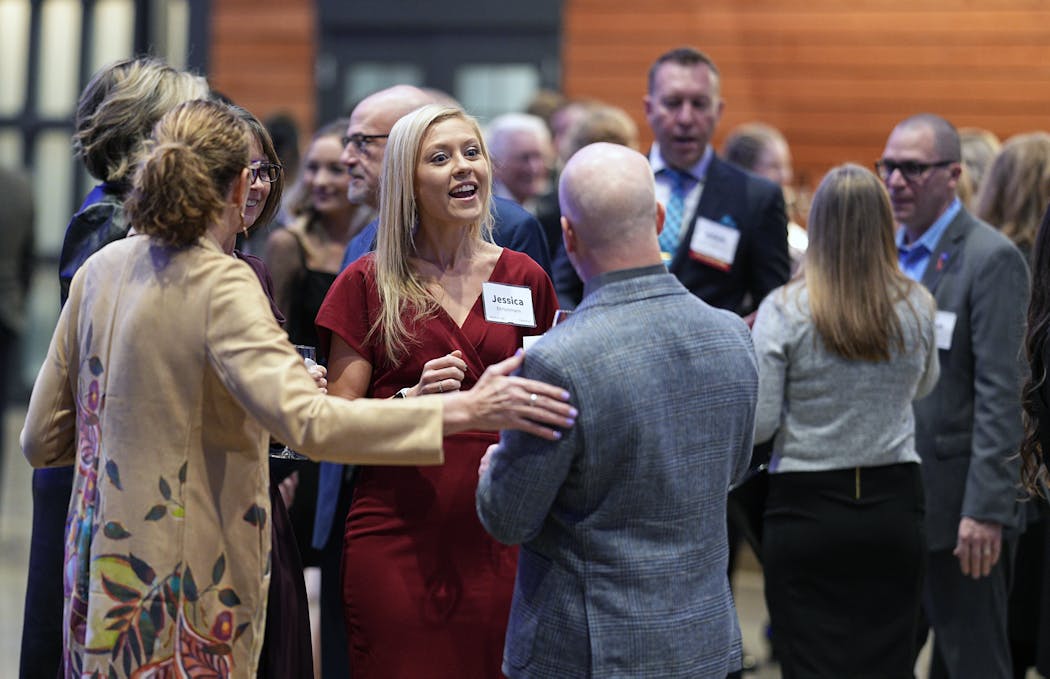No humans had to wear tuxedos, but a few dogs did at the Animal Humane Society's gala this fall — its first in-person event since the outbreak of COVID-19 in 2020.
The glitzy affair, complete with champagne, a silent auction and a relaxed dress code, was held at a northeast Minneapolis event venue rather than on computer screens, which became common practice during the pandemic.
"After attending so many [online events], people are tired of it and want to get back in person," said Shannon Hicks, the events manager at the Twin Cities-based Animal Humane Society.
After nearly three years of COVID-related disruptions, the galas and other big fundraisers that Minnesota nonprofits heavily rely on for donations — especially during this critical year-end period — are back on as usual.
Many nonprofits this year are financially stressed, in need of support after government pandemic aid ended. Some foundation grants have also returned to pre-pandemic levels.
In a new report from the Minnesota Council of Nonprofits, more nonprofits than last year say they're ending the year in deficit or just breaking even. A third of the nonprofits surveyed by the council expected to end the year in the red.
Nationally and locally, some nonprofits are seeing donations dip compared with the big spikes in giving when the pandemic first hit in early 2020.
But donations are trending up at more than 130 nonprofit galas and events that fundraising consultant Glen Fladeboe and his company have worked on this fall, even though fewer donors are showing up — likely because more people are spending time and money traveling.
"It's probably one of the most significant things I've observed in my career: Attendance in 2022 is slightly down, but many of our clients are raising as much or more money with fewer attendees," Fladeboe said. "Those donors who are in the room are passionate, and giving larger gifts."
Ironically, before the pandemic some nonprofits had been retooling typical black-tie events into online options to combat "gala fatigue" and reduce the cost of often expensive celebrations. When the pandemic hit, it forced most nonprofits to move fundraisers online.
That in turn led to "Zoom fatigue," prompting some organizations to resume in-person events in 2021. But a surge of COVID cases last fall pushed many events back online.
Fladeboe said most of his clients now are holding in-person events, with a smaller slice holding hybrid fundraisers. He said the hybrid model — inviting people to join a fundraiser both in-person and online — will likely be more popular post-pandemic.
"Right now in 2022, people wanted to come back together," he said. "[The event model] will change and move, based on where the public is at."
Wearing heels again
The Humane Society had planned to host an in-person event in fall 2021, but rising COVID cases nixed it and pushed it to September this year. More than 300 people and 100 dogs showed up for the party, which included a "canine concierge" taking pups out for potty breaks. While humans dined on hors d'oeuvres and sipped champagne, their pets devoured "pupcakes" before posing for portraits or in a photo booth.
"Everyone was a VIP, including the dogs," Hicks said.
Amy LeBard struggled to find an outfit for the American Cancer Society's annual gala this month. "I haven't had a chance to wear my heels in, like, two years," said LeBard, marketing director for the Cancer Society in Minnesota.
The Cancer Society's in-person gala in northeast Minneapolis drew 300 people, nearly double the attendance of 2019. It held an online event in 2020 and a limited hybrid event in 2021.
"The eagerness to get out, dress your best, really get to meet people and see the impact in person — it's just more engaging," LeBard said. "It's a great opportunity for people to reconnect again."
Second Harvest Heartland's October gala was also its first in-person event in two years. The party thrown by the Brooklyn Park-based nonprofit, one of seven food banks in Minnesota, attracted more than 750 people and drummed up $1.2 million — more than double the amount virtual galas in 2020 and 2021 brought in, and the most money ever raised at an event in the organization's history.
"It's hard to feel the heart of an organization from an email. But to do that in person ... it's definitely more powerful," said Megan Muske, Second Harvest's chief development officer.
Despite the event's success, donations this year to Second Harvest are below 2021 and 2020 levels, even as costs for food and fuel rise. About a quarter of Second Harvest's annual revenue comes from contributions.
"It feels like a slower start to the giving season," Muske said, adding that many first-time donors who gave at the start of COVID have dropped their support. "We're really concerned ... We hope people are going to stick with us."
Carolyn Parnell, 'trailblazer' who served as Minnesota's first IT commissioner, dies




